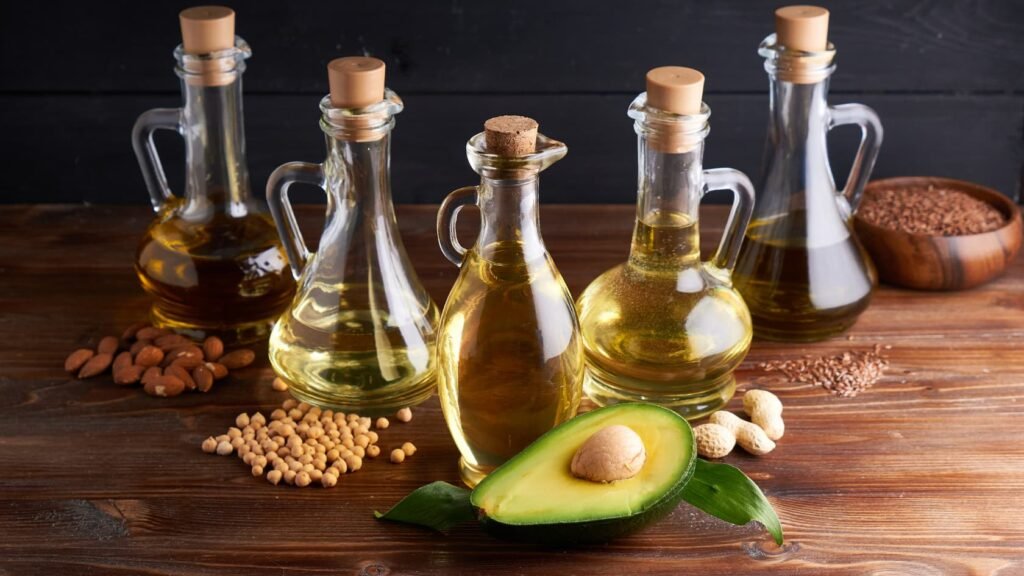Whether you’re baking, roasting, grilling, or searing, there are many different types of plant-based cooking oils to choose from.
The best oil for your cooking depends on things like what you’re cooking, the temperature you’re working at, and the flavor you want to impart to your dish.
Certain oils are better suited for specific cooking methods, so selecting the right one can make all the difference.
Considerations when choosing your oil:
Smoke point

If you’re baking at 350°F, roasting at 400°F or grilling at 600°F+, it’s very important to consider what temperature your oil begins to burn, also called its smoke point.
The higher the smoke point, the better it is for high heat cooking. A high smoke point oil can still be used for low heat cooking but so can other oils, as long as it has a smoke point greater than your cooking temperature.
Even when cooking with a heart healthy fat source, if an oil is brought to its smoke point, it can make it less beneficial for our health. Below you can find a chart with the smoke points for all 11 plant-based fat sources listed in both Fahrenheit and Celsius.
Flavor
Sesame oil and olive oil have very distinct flavors whereas avocado or canola oil are quite neutral. When looking at what you’re cooking it is important to consider if you want the flavor to complement the item or be non-existent.
Type of Fat (Saturated vs. Unsaturated)
Depending on what you’re cooking, different plant-based cooking oils have different textures they can impart on the food.
Particularly, with baked goods it is important to consider the properties and consistency of your oil.
For example, in pasty doughs a source of saturated fat is often cut into the flour. That way when it bakes the fat melts providing air pockets and texture. This gives the finished product that is light, rich, and crisp.
Plant-Based Cooking Oils:

1. Olive oil
Olive oil can have a lower smoke point which gives it better application in dishes with a lower cooking temperature. Additionally, with its strong flavor it’s also important to use it in dishes that pair well with its flavor notes.
That being said, there are many varieties of olive oil from extra virgin and cold pressed to refined or blended. With this variety you can get differences in smoke point, flavor, and nutritional value broadening its potential uses.
Below you will find more on varying smoke points, and the differences in refined or blended oils.
100 g (Extra virgin olive oil) has 93.7 g total fat, 69.2 g monounsaturated Fat, 9.7 g Polyunsaturated fat, and 15.4 g saturated fat [1].
2. Avocado oil
With its naturally high smoke point, avocado oil is great for higher heat cooking applications. It also has a neutral flavor, which is important if you’re not trying to impart any specific taste.
Additionally, avocado oil, like many plant-based cooking oils, is considered a heart healthy fat source. It has a high composition of unsaturated fat, coming from mainly monounsaturated fat.
100 g has 93.3 g total fat, 66.7 g monounsaturated Fat, 13.3 g Polyunsaturated fat, and 13.3 g saturated fat [1].
3. Canola oil
Neutral in flavor, canola oil is commonly used in moderate heat cooking applications and baking. It is comparably inexpensive to some oils and high in unsaturated fat making it a cost effective heart healthy plant-based cooking oil on a budget.
Because of its low cost, it is often also used to blend with other oils. This produces a lower cost oil that offers similar flavors as the original oil, with different properties.
100 ml has 94.5 g total fat, 62.6 g monounsaturated Fat, 25.3 g Polyunsaturated fat, and 6.6 g saturated fat [1].
4. Grape seed oil
Which is commonly used in baking, grape seed oil has a neutral flavor and high smoke point. It its fat comes mainly from unsaturated fat sources making it liquid at room temperature.
100 g has 93.3 g total fat, 66.7 g monounsaturated Fat, 13.3 g Polyunsaturated fat, and 10 g saturated fat [1].
5. Peanut oil
Peanut oil is low in saturated fat and often used in restaurants for frying.
However, you may be wondering why your food doesn’t come out with a nutty taste. That is because peanut oil is often refined to neutralize its aroma.
100 g has 93.4 g total fat, 57.1 g monounsaturated Fat, 19.9 g Polyunsaturated fat, and 16.2 g saturated fat [1].
6. Sesame oil
Fragrant in flavor with is nutty notes, sesame oil compliments many East Asian dishes.
However, with this oil, like olive, is important to consider the dish, as its strong aroma can easily be overpowering.
Additionally, with different varieties of sesame oil, toasted and untoasted, there are different uses.
Toasted sesame oil has a smoke point that is quite low, making it a poor choice for cooking. Because of this it mainly gets used in marinades, dressings, and to finish a dish.
Untoasted sesame oil, which is often just labeled as sesame oil, has a higher smoke point. Knowing this, it can be used to cook and/or enhance a dish with is fragrant aroma.
100 g has 93.3 g total fat, 40 g monounsaturated Fat, 40 g Polyunsaturated fat, and 13.3 g saturated fat [1].
7. Coconut oil
Coconut oil is high in saturated fat, making it solid at room temperature. Because of this it is often blended with other plant-based oils or used on its own in baked goods. This is to impart a comparable texture to something like butter or lard. It can however, impact the taste, so that is something to consider in its utilization.
100 g has 90.5 g total fat, 6.3 g monounsaturated Fat, 1.7 g Polyunsaturated fat, and 82.5 g saturated fat [1].
8. Sunflower oil
Sunflower oil, often used in sautéing, baking, dressing, marinades, or frying. It comes in several varieties: refined, unrefined, and high oleic. All of these may change what you want to use it with.
High oleic sunflower oil is produced from a sunflower breed made to have higher amounts of oleic acid. Oleic acid is a type of monounsaturated fat found in other fat sources, such as olive oil and avocados as well.
100 g has 93.2 g total fat, 63.4 g monounsaturated Fat, 20.7 g Polyunsaturated fat, and 8.99 g saturated fat [1].
9. Corn oil
Corn oil, like may oils on this list, corn oil is commonly used in frier with is low cost and neural taste. However, it can also be used in baking, dressings and marinades.
100 g has 94 g total fat, 27.7 g monounsaturated Fat, 52.9 g Polyunsaturated fat, and 13.4 g saturated fat [1].
10. Rice bran oil
With a high smoke point, rice bran oil is great for high heat cooking applications where some of the other oils can’t withstand the heat.
100 g has 93.3 g total fat, 40 g monounsaturated Fat, 33.3 g Polyunsaturated fat, and 20 g saturated fat [1].
11. Soybean oil
With a neutral flavor and low cost, soy bean oil is often used on its own or blended with other oils.
Although you might not find it labeled as soybean oil, vegetable oil is commonly soybean oil. However, sometimes vegetable oils are a blend of other plant-based oils with or without soy bean oil.
If your looking for something in particular, checking the ingredients can help you determine what type of vegetable oil you are getting.
100 g (soybean oil) has 94.6 g total fat, 22.1 g monounsaturated Fat, 57.6 g Polyunsaturated fat, and 14.9 g saturated fat [1].
Plant-based Oils Smoke point [2,3,4]
| Oil Type | Smoke point (°F) | Smoke point(°C) |
| Rice bran oil | 450-500 | 232-260 |
| Grapeseed oil | 445-485 | 229-252 |
| Canola oil | 435-460 | 224-238 |
| Soybean oil | 440-450 | 227-232 |
| Peanut oil | 420-450 | 216-232 |
| Sunflower oil | 410-450 | 210-232 |
| Avocado oil | 400-450 | 204-232 |
| Extra-virgin olive oil | 350-410 | 177-210 |
| Corn oil | 410 | 210 |
| Sesame oil | 410 | 210 |
| Virgin Coconut oil | 350 | 177 |
Above you may notice a large range of smoke points for some oils. The discrepancies in an oils smoke points often come down to the purity of the oil (is it blended with other oils or not) and if it is refined or not (Extracted with heat or cold pressed).
Blended plant-base cooking oils
Blended oils are the combination of two or more oils. For example you may see blended olive oil which may be mixed with canola or soybean. Doing this creates a cheaper oil that offers some of the notes of olive oil with a higher smoke point.
Refined plant-based cooking oils
Refined oil, which is extracted with heat, produces oil with a higher smoke point. However, they are also often considered lower quality particularly for oils such as olive. Extracting with heat neutralizes some of its aroma and flavor in the olive oil. Additionally, the process can also destroy some of the nutrient contents.
Oil storage
Plant-based oils do have a shelf life and there are certain storage methods that can make them go rancid, or bad, faster. Rancid oil has an unpleasant taste and smell and can be harmful to your health.
Exposure to air, moisture, sunlight, and heat can make oils go rancid faster. It is important to store oils in a cool, dry, and dark area in an airtight container.
Take Away
There are many plant-based cooking oils to choose from. Considering the flavor, cooking temperature, and product you’re cooking is important determination when choosing the right oil.
Additionally, although there are many heart healthy cooking oils which are low in saturated fat, not all plant-based oils are. Make sure you are choosing the right oil for your health goals as well. The breakdown of the source of fat is noted under each oil above.
For more other sources of plant-based fat aside from cooking oils, check out “11 Plant-Based Fat Sources“.
Found this article interesting? Sign up for our email list here so you don’t miss out on new blog posts, recipes, or exclusive content.

Pingback: Can You Eat Popcorn on a Plant-Based Diet? - Fig Lane Nutrition
Pingback: Olive Oils Smoke Point - Fig Lane Nutrition